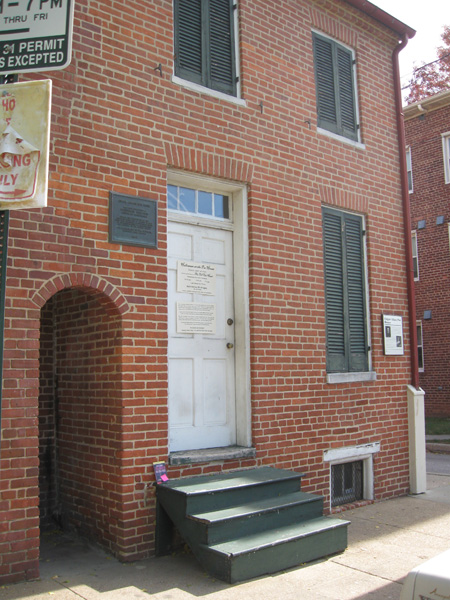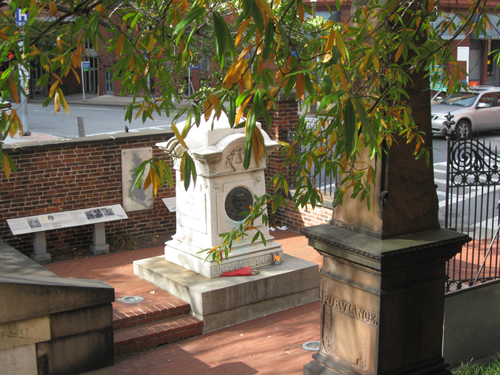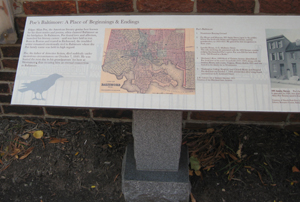Adventures in Baltimore with Edgar Allan Poe
This post is part 19 of our Wednesday Adventure Series. Each week we will highlight something different in the Washington, D.C., Metro Area, many of which will be options for part of your own BookCrossing Journey. With so many things to see and do, how will you choose?
Help out the Convention: Have you seen the new Donate page? You’ll get a listing on the thank you page, wings for a month, and a say in what colors the convention team dyes their hair!
Baltimore, Maryland, is known to Edgar Allan Poe enthusiasts as the place that “defines the beginning and the end of his life.†Poe worked and lived in Baltimore for many years. And it is in Baltimore that he died in 1849. You will find traces of Poe and references to him throughout the city of Baltimore. The Baltimore Ravens football team, for example, have mascots named Edgar, Allan, and Poe, who are ravens (after Poe’s famous poem).
One significant Poe site in Baltimore is the house on Amity Street where he lived with his aunt and cousin (his future wife, Virginia) for several years. It is thought that much of his early work was penned while he was at this house, including stories such as “MS. Found in a Bottle,†“The Visionary,†and “Morella†and poems to include “Enigma [on Shakespeare],†“Serenade,†and “The Coliseum.â€
Edgar Allan Poe was buried in Westminster Burying Ground, where you will find a grand, gothic church and catacombs. He was originally buried in a family lot and had no headstone for years after his death until a sandstone block with the number “80†was placed to mark his grave, which was neglected and overrun with weeds. In 1860, Poe’s relatives commissioned a small headstone, which was destroyed in a train accident before it even made it to the gravesite. A second stone was designed, but the family did not have the money to purchase it. Near the end of the Civil War, citizens raised half of the necessary funds for a Poe Memorial; the other half came from a single donor, Mr. George W. Childs of Philadelphia. Though it did not befall the calamity of his prior headstones, it does erroneously list Poe’s birth date as January 20 instead of January 19. The monument was placed in a distinguished position at the corner of the burial grounds in 1875. The Poe family plots are located on the other side of the burial grounds, so Poe’s remains were dug up and moved to the memorial site.
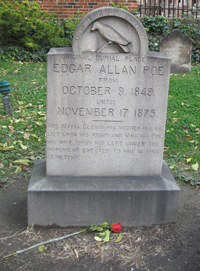 The memorial still stands today, as does a gravestone which supposedly marks the spot where Poe had originally been buried. That stone was initially placed in the wrong spot and was moved around several times, leading a few people to wonder not only where Poe’s original burial spot was but also if the man who was moved to the spot by the memorial is even Edgar Allan Poe. Between these post-mortem adventures and the still unsolved mystery of his death, it is somewhat fitting that Poe is so well-known for his tales of horror.
The memorial still stands today, as does a gravestone which supposedly marks the spot where Poe had originally been buried. That stone was initially placed in the wrong spot and was moved around several times, leading a few people to wonder not only where Poe’s original burial spot was but also if the man who was moved to the spot by the memorial is even Edgar Allan Poe. Between these post-mortem adventures and the still unsolved mystery of his death, it is somewhat fitting that Poe is so well-known for his tales of horror.
Many Baltimore residents love mysteries as much as Poe did. The mystery of the Poe Toaster is one that may never be solved. This anonymous stranger visited Poe’s grave on the night of Poe’s birthday every year from 1949 until 2009. He would leave three roses on Poe’s grave (for Poe, Poe’s mother-in-law, and Poe’s wife) and drink a toast with cognac. He did not appear at the grave in 2010 or on January 19 of this year, leading everyone, including Jeff Jerome of the Edgar Allan Poe Society, to believe the tradition has ended. Many people still visit the memorial on Poe’s birthday as well as throughout the year.
Other Poe-related sites in Baltimore include Church Hospital (where he died), Fell’s Point (where he may have frequented taverns), Lexington Market (where he bought goods), the Latrobe Home (where Poe’s “MS. Found in a Bottle†was awarded a fifty-dollar prize in a contest sponsored by the Baltimore Saturday Visitor), and the modern day Annabel Lee Tavern (named after another of Poe’s poems).
Visiting several historic Poe sites is part of the Baltimore trip that you can choose for a Sunday add-on. The Poe house is now a museum, but it is not open on Sundays. You will be able to walk around Westminster Burying Ground, however. If you cannot attend the Baltimore trip, you can experience Edgar Allan Poe’s Baltimore using a wonderful interactive map showing places in Poe’s time and places today.
Donate to the Convention Today!
Do you want to help out the 2011 Convention and get something out of it? There are now three awesome benefits for our Bookworm convention donors:
Donate to the Convention and Get:
*Listed on the thank you webpage, which will remain online in perpetuity, with your name or screen name and a link to your website or BookCrossing bookshelf!
*Wings for a month(for you or for a friend), courtesy of a generous anonymous donor!
*A chance to choose the color we dye our hair!
Find out more and donate with just the click of a button here: http://www.bcindc.zoiks.org/?page_id=844
Info About Accessible Activities
The theme of our convention is Choose Your own BookCrossing Journey. However, we realize that all our attendees’ limitations are different and some people might require additional information to choose scheduled activities that will be most enjoyable for them.
Therefore, we now have information for you to consider that takes into account mobility and other concerns. Special arrangements can be made upon request if we are given enough notice. Check out the new Accessible Activities page.
Adventures at the Bureau of Engraving and Printing
This post is part 18 of our Wednesday Adventure Series. Each week we will highlight something different in the Washington, D.C., Metro Area, many of which will be options for part of your own BookCrossing Journey. With so many things to see and do, how will you choose?

The Bureau of Engraving and Printing (B.E.P.) is mostly known for printing paper currency used in the United States. However, it’s also responsible for printing Treasury securities, military commissions and award certificates, and security documents and identification cards for a variety of Government agencies. It even printed stamps from 1894 until 2005. What it is not responsible for is coinage, which is produced in Philadelphia and Denver at the United States Mint. There are two locations of the B.E.P.: Fort Worth, Texas (where the 2005 BookCrossing Convention took place) and Washington, D.C. (where the 2011 BookCrossing Convention will take place).

Some fun facts about the B.E.P. and money include:
· A bill (or note) weighs about 1 gram
· The largest denomination note ever printed was a $100,000 Gold Certificate, Series 1934
· The Secretary of Treasury is responsible for choosing the design for the notes
· By law, only portraits of deceased individuals may appear on currency
· A $1 bill’s lifespan in circulation is roughly 42 months, during which time its travels may be tracked at wheresgeorge.com.
· Bally Bucks issued at the 2011 Convention are not legal tender
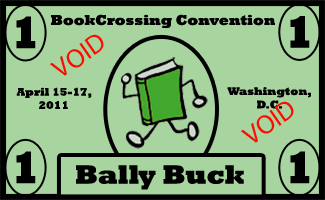
The B.E.P. is integral to the US, as we use what it produces every day. However, it was not in the original government plan for the country. There was a drain on the supply of coin currency during the Civil War, so in 1861 the government realized another option should be instituted. A private company was hired to print Demand Notes (like IOUs from the Government). The sheets of notes were sent to the Treasury Department where many different clerks cut the notes apart and signed them.
It still took time and many changes to get from that stage to what we have today. The agency went through many names including: National Currency Bureau, Printing Bureau, Small Note Bureau, Currency Department, and Small Note Room. In 1874, congressional legislation made the name “Bureau of Engraving and Printing†stick.
By 1864, the B.E.P. already printed more than just currency and notes. They were responsible for producing Treasury bonds and even passports for the State Department. It wasn’t until the sale of bonds during World War I in 1918 that the power presses at the B.E.P. were redesigned to print eight notes per sheet instead of just four. Currency itself was redesigned in 1929 to standardize size, allow twelve notes to be printed per plate, and combat counterfeiters. Today’s bills are being redesigned slowly to combat modern day counterfeiters; the new $100 bill is just now being released with new security measurements. And today we use systems that can print 32 notes per plate in a process of inking, wiping, and pressing the paper (made of 75% cotton and 25% linen) into the plate where the engraved lines still contain ink.

You can see this process firsthand by touring the Bureau of Engraving and Printing, which is one of your Friday morning early bird add-on choices for the 2011 BookCrossing Convention. Guided tours are 30 minutes long and you will have a chance to visit the gift shop where you can buy anything from shredded money to sheets of uncut currency. You can find out more about the B.E.P. by visiting their aptly-named website: http://moneyfactory.gov.
Convention Day Pass
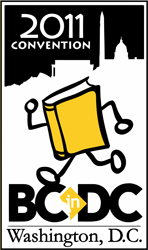 Due to popular demand, we are pleased to now offer 2011 BookCrossing Convention Day Passes. The price for day passes on Friday or Sunday are $50 each and the price for Saturday is $100. This includes whatever activities and meals will take place as outlined on the Convention Schedule. So if you’re only able to attend for a day, now you can join in on the fun. Register for the Convention and get ready to Choose Your Own BookCrossing Journey with us!
Due to popular demand, we are pleased to now offer 2011 BookCrossing Convention Day Passes. The price for day passes on Friday or Sunday are $50 each and the price for Saturday is $100. This includes whatever activities and meals will take place as outlined on the Convention Schedule. So if you’re only able to attend for a day, now you can join in on the fun. Register for the Convention and get ready to Choose Your Own BookCrossing Journey with us!





